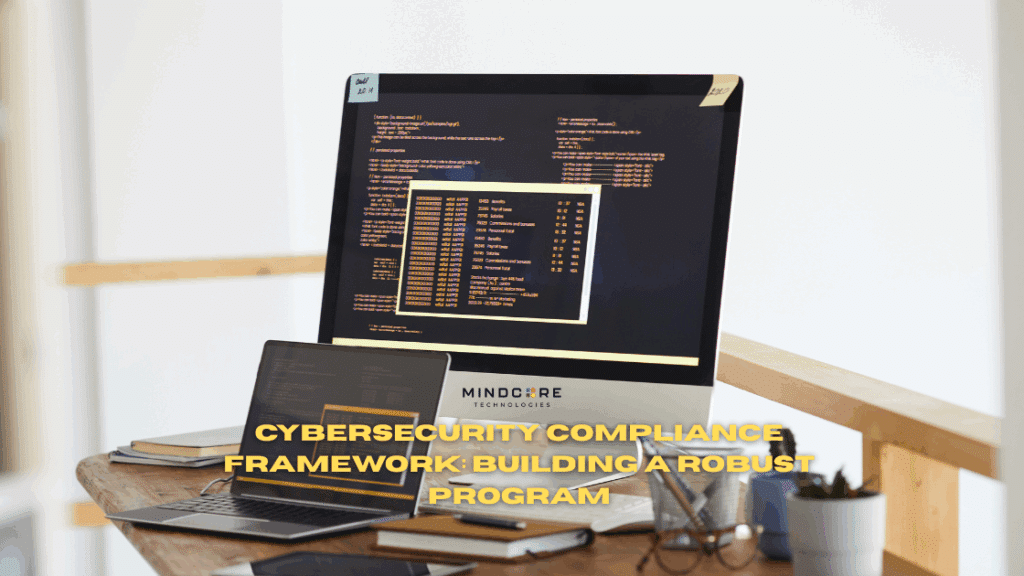Cybersecurity threats keep evolving, and businesses can no longer afford to be reactive. A strong cybersecurity compliance framework gives companies a way to stay ahead. It connects policies, tools, and teams under one system, helping reduce risk and meet regulatory demands.
But what does building a framework really involve? And how can you make sure it fits your business, not just the textbook? In this post, we’ll break down what a cybersecurity compliance framework is, what it should include, and how to build one that works.
What Is a Cybersecurity Compliance Framework?
A cybersecurity compliance framework is an organized set of procedures that assists businesses to maintain their IT security and comply with regulations. In this sense, it acts as a kind of road map, telling you what to manage and how to organize your efforts in security.
Through these frameworks, you are thus sure that your enterprise meets standards such as HIPAA or PCI DSS, to name a few. They do not only guard you against fines. They ensure that you run your business in a secure and accountable way.
Unlike checklists, frameworks tend to be more flexible. Depending on your size, industry, and objectives, it can be one way or another. It assists with proactive protection and in going through an audit.

Core Components Every Framework Must Include
A good cybersecurity compliance framework isn’t just technical. It brings people, processes, and systems together. These are the basic parts it should cover:
1. Governance Structure
Define roles and responsibilities clearly. Who owns each part of your security? Who approves policies? This ensures accountability.
2. Policies and Procedures
You need written policies that explain how things should be done. These cover areas like access control, data use, and third-party risk.
3. Risk Management
You need a method for identifying, evaluating, and responding to risks. This step helps you prioritize what to fix first.
4. Control Implementation
Apply the right technical and administrative controls. This might include encryption, monitoring tools, or staff training.
5. Audit and Monitoring
Regular reviews and logs help verify that your controls are working. This also makes future audits easier.
6. Incident Response
Have a plan in place for security incidents. Include steps for detection, reporting, and follow-up.
When you put these pieces together, you create a working system—not just a document. It supports your overall cybersecurity compliance program and allows for real-time accountability.
Commonly Used Frameworks (And When to Use Them)
Not every framework is the same. Here are some of the most popular ones and the scenarios when they would apply to your business:
- NIST Cybersecurity Framework: Best for U.S.-based organizations or government contractors. It offers five core functions: Identify, Protect, Detect, Respond, and Recover. It’s flexible and easy to map to other standards.
- ISO/IEC 27001: Is a worldwide standard, often used in case of multinational companies. It is a complete framework for information security management systems (ISMS).
- CMMC: Required for U.S. defense contractors. It blends practices from NIST with levels of maturity.
- SOC 2 and COBIT: Most common in SaaS and IT-heavy organizations. SOC 2 deals with trusting service providers, while COBIT deals with governance.
If you don’t know where to start from, begin by establishing which regulations relate to your business, and then select the framework that best suits your needs. They usually belong to a bigger cybersecurity compliance service package offered by a third party.
How to Build a Framework That Actually Works

The following are practical steps for building a framework that assists your business, not just a dry set of rules:
- Start With a Gap Assessment: Identify what you are already doing and where your gaps lie. Use tools or outside experts if needed.
- Map Out Standards: Align your controls with recognized standards such as NIST or ISO. The audits become easier, and it’ll help you go for certifications down the line.
- Customize to Fit the Risk Profile: Are all risks equal? Controls should address your biggest threats, not just what looks good on paper.
- Collect Inputs from All Departments: The IT guys cannot do it by themselves. HR, Legal, and Operations should be involved to ensure true alignment.
- Make It Maintainable: Do not bloat your policies. Use clear naming conventions, create schedules for periodic review, and setup version control. These small measures keep the content usable.
A strong framework also eases adoption of a cybersecurity compliance standard further down the road, particularly if an organization plans to grow.
Mistakes to Avoid When Building Your Program
It’s easy to fall into common traps when creating a cybersecurity compliance framework:
- Overcomplicating things: Simplicity helps teams follow policies.
- Using templates without edits: Each business has unique risks.
- Not assigning owners: If no one owns a policy, it won’t get enforced.
- Ignoring regular updates: Standards change. So should your program.
- Skipping documentation: If you can’t prove it, it didn’t happen.
These mistakes often lead to compliance issues later, especially when businesses are preparing for a cybersecurity audit or a client review.
When to Seek Help (And What to Look For)
If your internal team lacks experience, it may be time to bring in cybersecurity compliance services. Here are signs that you need help:
- You’re expanding into a regulated industry
- You’ve failed an audit or assessment
- Your clients demand proof of compliance before signing
When choosing a provider, look for one that:
- Specializes in your industry
- Offers ongoing support, not just templates
- Knows how to manage frameworks like ISO or CMMC
This can help you avoid wasted effort and focus on what matters. It also gives your team breathing room to focus on business operations.
Keeping Your Framework Future-Proof
Once built, your framework isn’t done. It should evolve.
- Track changes in law and industry standards
- Set quarterly review cycles
- Test your incident response plan annually
- Use GRC tools or access control platforms like Silverfort to automate compliance
Keeping up with updates lets your team stay audit-ready. It also supports career paths in cybersecurity compliance because your analysts gain experience in real-world frameworks.
Final Thoughts: A Strong Framework Builds Business Confidence
A cybersecurity compliance framework helps you stay secure, legally protected, and ready for anything. It connects people, process, and technology to build trust with clients and partners.
When done right, it also saves time. You won’t scramble when audits come up. You won’t lose deals due to compliance gaps. And you’ll be ready for growth with a structure that scales.
Whether you’re starting from scratch or improving an existing system, building a smart, adaptable framework is one of the best things you can do for your business.

